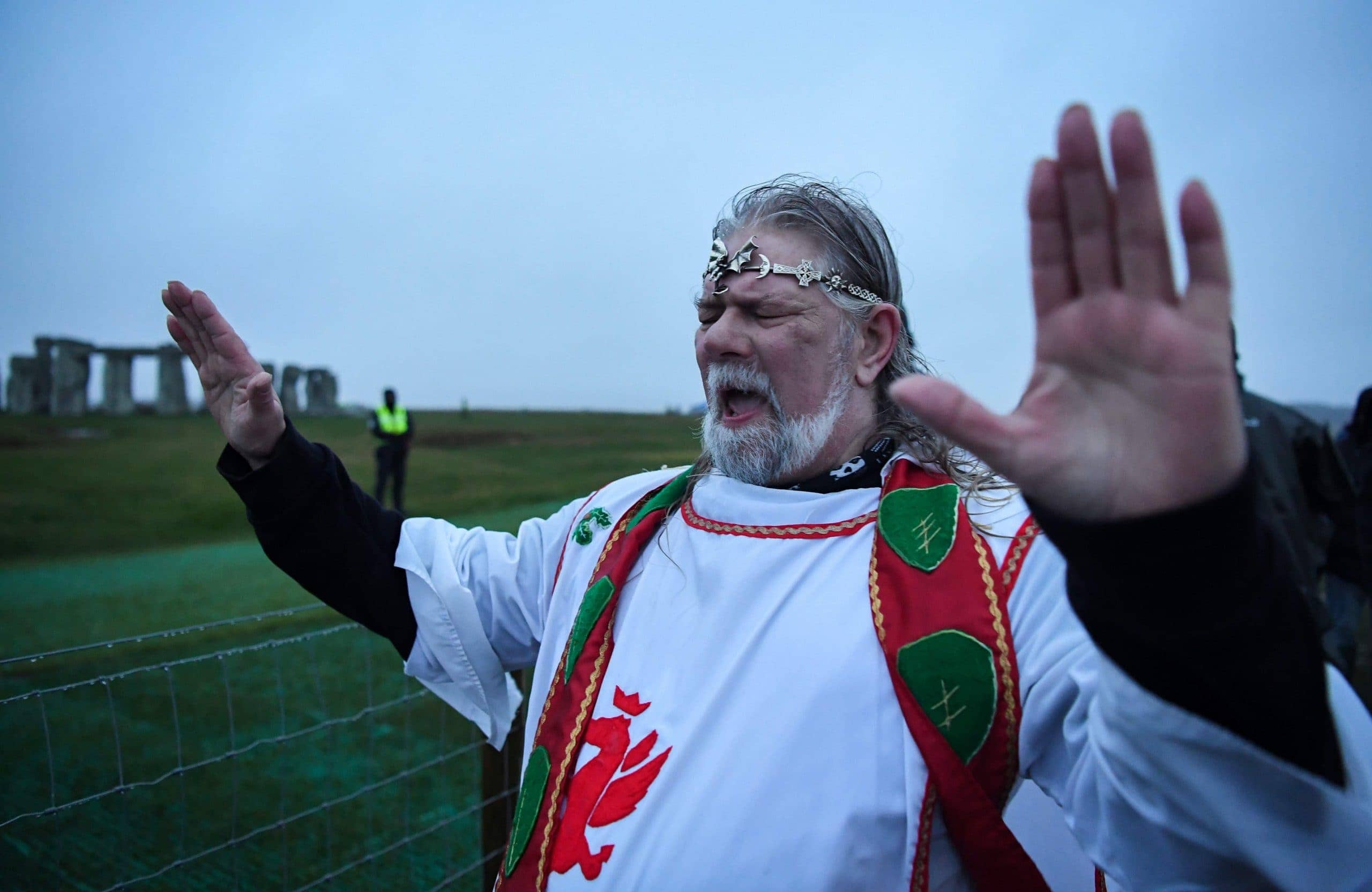
In anticipation of the Summer Solstice, we dive into a mysterious group that links Stonehenge and Star Trek, King Arthur and Babylon 5, Christianity, Paganism, Zen Buddhism, New Age shamanism, Freemasonry, environmentalism, Julius Caesar, William Blake and the cosmos: druidry.
A quintessentially English tradition – or should I say culture? Or lifestyle? Or cult? Or religion, perhaps?

A druid participating in a dawn ceremony as part of the Midsummer Rites at Stonehenge, 1956. (Photo: Thurston Hopkins)
Actually, religion probably is the most correct term – these days at least. Because, back in 2010, the Druid Network was granted charitable status by the Charity Commission for England and Wales, making Druidry, in effect, a recognised religion.
The movement sparked controversy, the loudest peal of dissent sounding from Melanie Phillips, Britain’s “leading right wing voice,” who wrote in the The Daily Mail, “Will someone please tell me this is all a joke?”. Phillips’ criticisms were predictably conservative: she didn’t like the idea of druids being afforded the same status as Christians, because, unlike Druidry, so-called “true religions,” she claimed, “rest on an established structure of traditions, beliefs, literature and laws” and “share a belief in a supernatural deity (or more than one) that governs the universe.”
Phillips is right, technically speaking. Consider the following line, which appears under the ‘Beliefs’ section of the Wikipedia page for ‘Druidry (Modern)’: “Druidic beliefs vary widely, and there is no set dogma or belief system followed by all adherents.” It’s also on Wikipedia – that reliably unreliable font of knowledge – that you get a sense of the many and varied sources from which druids draw their influence – the King Arthurs, the Babylon 5s, and so forth. But all this leaves many questions unanswered. Like, who exactly are the druids? Why are some people so upset about them? And do they really bear any resemblance to their ancient, human-sacrificing forefathers?
ArrayOak Knower
The etymological origins of the word “druid” remain shady, but general consensus suggests that the term means “oak knower,” laced with shades of “seer” (Old Cornish drew), “sorcerer” (Old Irish druí), and “wren” (Middle Welsh, dryw). The original druids left behind no written record; the first detailed description appears in Julius Caesar’s Commentarii de Bello Gallico, written at some point in the 50s BCE.
Here, druids appear as barbaric high priests, sacrificing criminals (or innocents, depending on availability) by burning them alive in a huge wicker man. Today, scholars disagree on the reliability of Caesar’s text, some giving credence to his descriptions of primitive barbarity, others treating it as little more than apocryphal propaganda, fictionalised to entrench a sense of Rome’s civility. The truth is probably somewhere in the middle.
All we really know is that, at some point after the Romans invaded Britain, druids died out, disappeared, or just fell out of fashion (the same is not quite true of Ireland, which was never invaded by the Romans, though there’s little evidence to suggest that druids persisted), and were largely forgotten until the seventeenth-century; which was when things started to get juicy.

Senior druid King Arthur Pendragon. (Photo: Finnbarr Webster)
It all began with a man named John Aubrey, who, at some point in the 1600s, suggested an (incorrect) connection between the ancient druids and Stonehenge (we now know that Stonehenge was built millennia before the Iron Age, when druids first appeared). His supposition remained confined to his diaries, until an eighteenth century reader, William Stukeley, got hold of them, and widely publicised the notion. And just as Carter’s discovery of Tutankhamen’s tomb sent Ancient Egyptian shockwaves across the 1920s, so, too, did Stukeley kick-start a Druidic revivalism that would carry into the present day.
That mythic Arcadia
The first Druidic orders of the eighteenth-century tended to be fraternal groups, like the Freemasons, where men with a shared interest in music could gather for social events. Figures like the poet William Blake also looked to Druidry, but from a mystical point of view – not religious, exactly, but Romantic, a hazy gaze into Britain’s pagan past in the midst of enlightenment cultures and industrialised societies.

Unsurprisingly, the revival of Druidry gained traction amongst nationalists, particularly in Wales. One Edward Williams – later to become Iolo Morganwg – spearheaded this resurgence in the late eighteenth century, blending his Druidic interest with anti monarchical leanings and outspoken support of the French Revolution.
It was through Morganwg that Druidry shifted from cultural curiosity to something like a religion; he even fabricated literary sources and traditions, which, he claimed, dated back to prehistoric Druidry, including the Celtic ritual Gorsedd (still practiced today), and The Druid’s Prayer, which loosely takes the form of the Lord’s Prayer (“Grant O Goddess, thy protection, and in protection, strength, and in strength, understanding…”).

A large lintel is placed on the top of two other stones during restoration of Stonehenge. (Photo: Three Lions)
Thus, Modern Druidry was born: not from the ashes of the ancient pagans, but from a desire for the past so desperate that forgery and fakery was (and still is) deemed acceptable. To some extent, it’s neither a surprising nor an unfamiliar phenomenon – the art and literature of the seventeenth and eighteenth centuries is marked out by its Romantic gaze away from the steam engines and factories of industrialisation, back towards a mythic Arcadia of times past.
But, that’s art and literature; forms, in other words, that are content with crafting a fiction. Druidry, on the other hand, has done its very best to root itself in actuality – to dig up sources and forge connections with real fragments from history – which almost always turn out to be erroneous. The magic of it is that many druids stick to this narrative anyway.

Artistic representation of a full Stonehenge and Druid gathering
The pull of the pastoral
In the nineteenth and twentieth centuries, Druidry swept across England, rearing its head with renewed vigour every time another pastoral revival took hold. As such, Druidry has its roots very firmly planted in British soil; in a deep-seated connection, that is, with the British landscape, its monuments, monoliths, and diurnal rhythms. Along with Stonehenge, sites like Glastonbury, Avebury (in Wiltshire), and Chanctonbury Ring (in Sussex) draw groups of Neo-Druids, who invest these sites with mystical import.
Chanctonbury, by the way, is just up the road from the quaint little village of Steyning, where famed occultists Aleister Crowley and Victor Neuburg lived – and that’s no coincidence. The early twentieth century was another moment marked out by a return to the English pastoral (in music, art and literature, think Ralph Vaughan Williams, the Bloomsbury set, and Eric Gill and the Guild of St Joseph and St Dominic), and an interest in the occult was just another side of the same coin. As you can imagine, the period led to another boom in Druidry and paganism, culminating with the repeal of the Witchcraft Act of 1736 in 1951, and the arrival of Wicca shortly after, in 1954.

With their reverence for the natural world (one of the few tenets that applies to most Druidic groups), druids were amongst the first vegans and vegetarians, the first eco-warriors, the first to protest against the building of motorways through England’s green spaces; and they’ve also been amongst the first to voice anti-vaccination and Covid-denial.
In a November 2020 blog post, the group Celtic Druid Temple, part of the Celtic Druid Alliance, outlined the right to refuse vaccination based on articles from International Human Rights Law, while, in December, senior druid, King Arthur Pendragon, complained that English Heritage had “us[ed] the Covid crisis as an excuse” to stop druids from celebrating Winter Solstice at Stonehenge.
Gruesome but true
These last two points are interesting, because they raise an important point about the relationship between Druidry and the mainstream. Ever since their resurgence in the eighteenth century, druids have enjoyed an identity as an alterity group, a community on the fringes, openly critical of mainstream society for its consumerism, its environment exploitation and its reverence of technology.

And yet, over the last few years, druids have worked harder and harder to lodge themselves into the very society that they reject: they want to be recognised as a religion by the Charity Commission for England and Wales; they make use of International Human Rights Law, the very laws that governs how we act in mainstream society. What’s more, the druid demographic, in both the UK and North America tends to be very white, very straight, and very middle class: these are not the disenfranchised few.
All of which brings us back to Melanie Phillips and her incredulity back in 2010; an incredulity that has grounds, but not the ones that she laid out. Because it’s not a lack of coherent tenets, or an absence of the right kind of deity that problematises Druidry, but a certain disingenuousness belying the movement.
these are not the disenfranchised few
It’s the fact that it superficially (and often quite vociferously) rejects the mainstream, while, at the same time, seeking to merge with it, and that it’s built on a myth that masquerades as fact. Because, let’s face it, there are some canonical texts that druids could draw on – but then we’d be seeing an awful lot of human sacrifice across England’s green and pleasant lands. Sure, it’d be gruesome – but it would be more honest than Stonehenge, Gorsedd and The Druid’s Prayer. In fact, it’d be about the only thing tying modern druids to their pagan forefathers.


